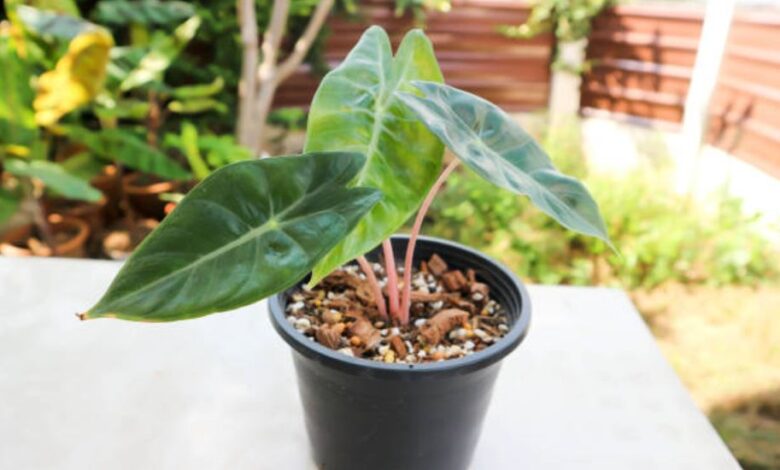Caring for Rare Beauties: Alocasia Pink Dragon & Alocasia Jacklyn Plant Tips

In the world of rare houseplants, few species captivate collectors quite like the stunning Alocasia Pink Dragon and the distinctive Alocasia Jacklyn. Known for their bold foliage and exotic charm, these plants bring a tropical elegance to any indoor space. However, their beauty comes with a need for special care. Whether you’re a seasoned collector or just starting to explore the Alocasia family, understanding their specific needs is crucial to keeping these tropical treasures thriving.
Introducing the Rare Beauties
The Alocasia Pink Dragon is a true showstopper, admired for its glossy, dark green leaves contrasted by striking pink petioles (stems). This dramatic plant instantly becomes the centerpiece of any plant collection, thanks to its vibrant coloration and sculptural appearance.
On the other hand, Alocasia Jacklyn, a newer addition to the houseplant scene, features deeply lobed, bright green leaves with dark venation that gives it a bold, prehistoric look. Native to Indonesia, this species is a natural mutation of Alocasia portei and is highly sought-after for its unique leaf structure and growth habit.
Both of these rare varieties belong to the same genus, but they have distinct personalities and care requirements that plant enthusiasts should understand before bringing them home.
Light Requirements
Both Alocasia Pink Dragon and Alocasia Jacklyn thrive in bright, indirect light. Avoid placing them in direct sunlight, as this can scorch their delicate foliage. A spot near an east- or west-facing window filtered by sheer curtains is ideal. While Alocasia Jacklyn can tolerate slightly lower light levels, it will grow best when provided with abundant natural light without the intensity of direct rays.
Watering & Humidity
These tropical plants crave moisture, but overwatering is a common mistake. Use a well-draining potting mix and ensure your pot has proper drainage holes. Water only when the top 1-2 inches of soil feels dry to the touch. During the growing season (spring and summer), they may require more frequent watering, while in winter, their water needs reduce significantly.
Humidity is essential for both plants. Aim for humidity levels of 60% or higher. A humidifier, pebble tray, or grouping your plants can help increase ambient humidity. Alocasia Jacklyn, in particular, thrives in high humidity and can suffer from browning edges if the air is too dry.
Soil & Potting
A lightweight, aerated soil mix is best. A mixture of potting soil, orchid bark, perlite, and a small amount of coco coir or peat moss offers excellent drainage while retaining just the right amount of moisture. Avoid heavy, compacted soils that can lead to root rot. Repotting is typically needed every 1-2 years as the plants outgrow their containers or the soil begins to degrade.
Fertilization
During the growing season, feed your Alocasia Pink Dragon and Alocasia Jacklyn with a balanced, diluted liquid fertilizer every 2–4 weeks. Avoid over-fertilization, as it can cause salt buildup and damage the roots. In fall and winter, when growth slows, it’s best to cut back on feeding entirely.
Pests & Problems
Common pests like spider mites, aphids, and mealybugs can affect both plants. Regularly inspect the undersides of leaves and the stems. If pests are spotted, treat them promptly with neem oil, insecticidal soap, or by wiping them off with a damp cloth. Leaf yellowing, browning edges, or stunted growth can also be signs of stress—often due to improper watering, low humidity, or poor lighting.
Root rot is a serious concern, especially for Alocasias. Ensure your potting mix and watering routine support healthy root systems. If the plant starts to decline, gently check the roots for mushy, dark areas and prune them away before repotting in fresh soil.
Seasonal Dormancy
Alocasias can enter a dormancy period in colder months, where growth slows or stops entirely. Don’t panic if your Alocasia Pink Dragon or Alocasia Jacklyn drops a few leaves or stops producing new ones during winter. Reduce watering and stop fertilizing during this time. Once spring arrives and temperatures warm up, you’ll likely see new growth emerge.
Propagation
Propagation is typically done by division when repotting. Look for offsets or tubers near the root system. Carefully separate these and plant them in their own pots with the same care guidelines. This method helps maintain plant health and allows you to share these rare beauties with fellow plant lovers.
Final Thoughts
The Alocasia Pink Dragon and Alocasia Jacklyn are not just house plants—they’re statement pieces that can elevate your indoor jungle with their exotic charm and dramatic foliage. With the right care and attention to their tropical needs, these rare Alocasias will reward you with vibrant growth and unparalleled beauty.
For plant enthusiasts who appreciate unique foliage and enjoy a bit of a challenge, adding these Alocasias to your collection is a decision you won’t regret. By understanding their preferences and providing the right environment, you can keep these botanical gems thriving year-round.





